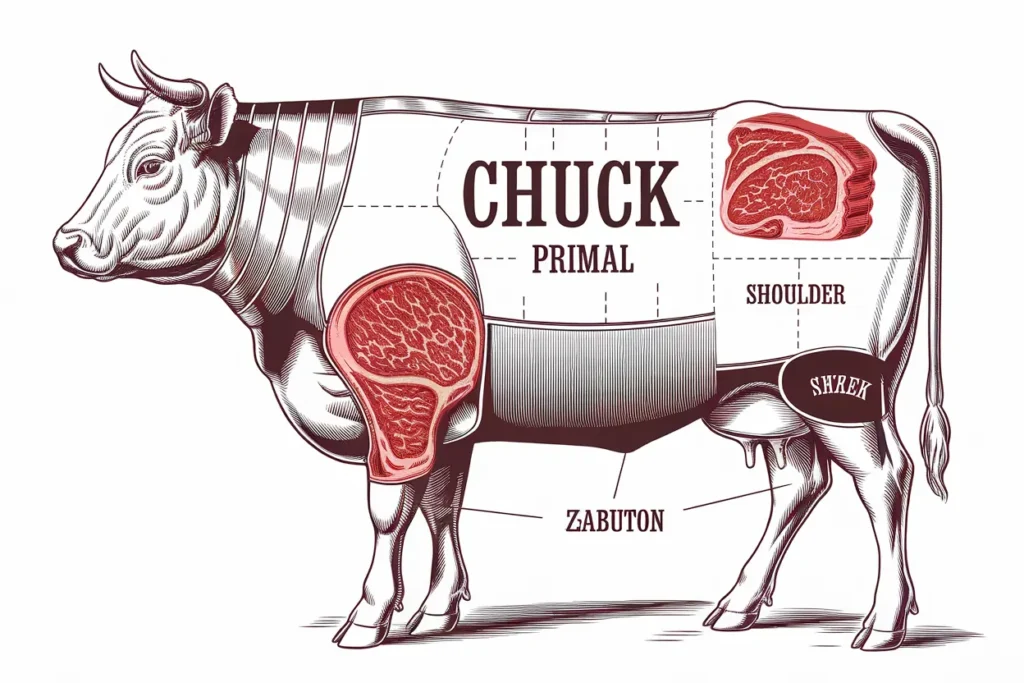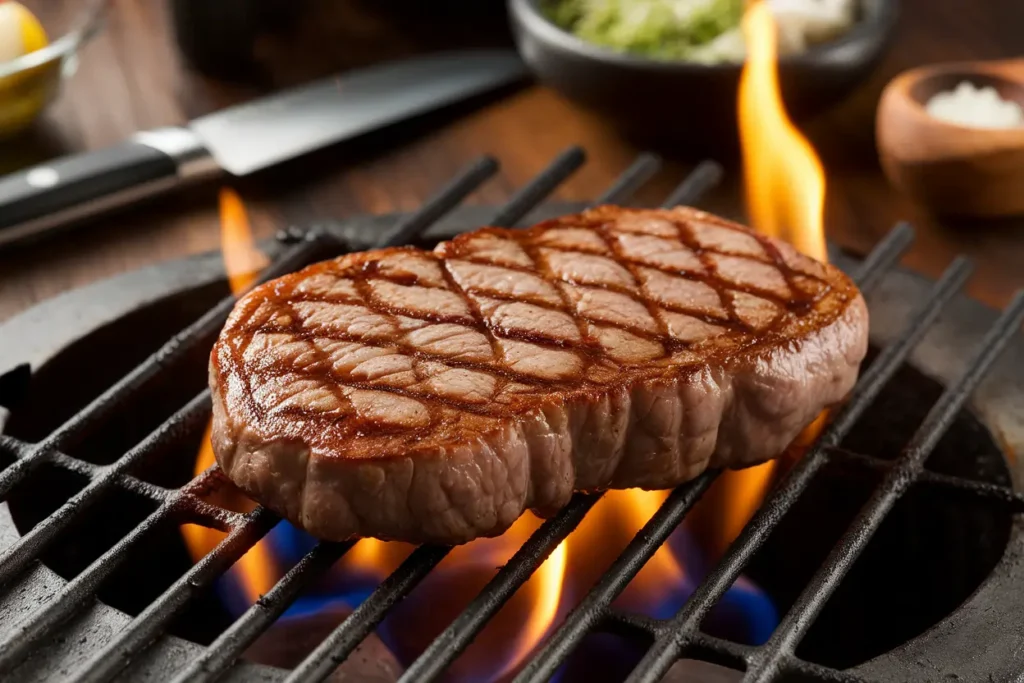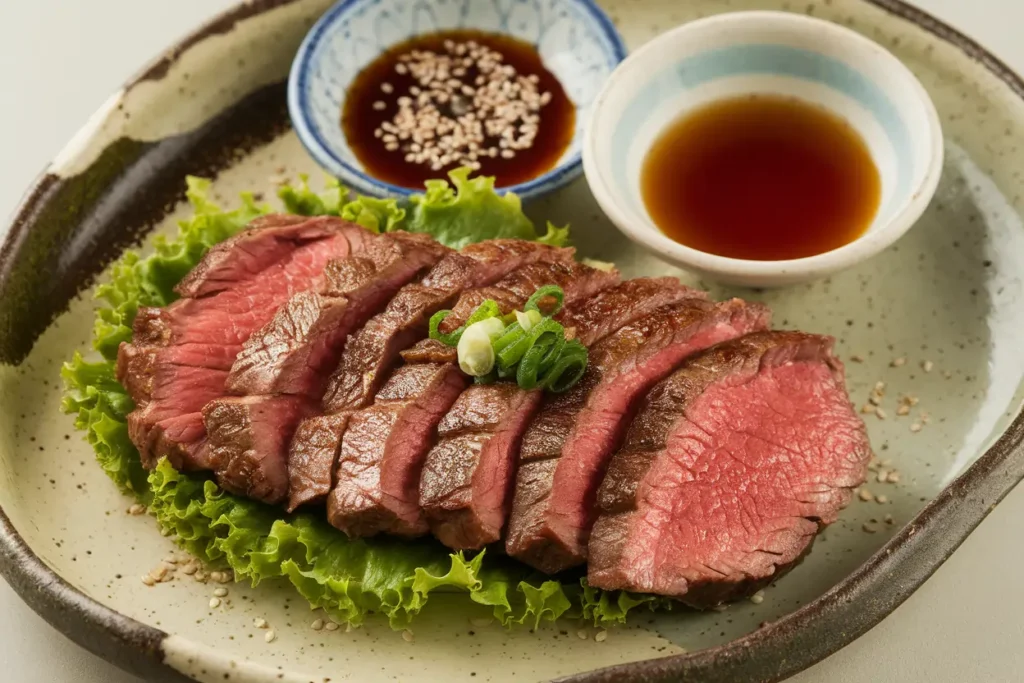Have you ever come across the term Zabuton steak and wondered, So, what cut of steak is Zabuton, and why is it gaining so much popularity? Let’s dive into this fascinating topic.” You’re not alone! The Zabuton steak isn’t as widely recognized as cuts like ribeye or filet mignon, but it’s gaining popularity among foodies and chefs alike. Let’s dive into what makes this cut of steak so special, where it comes from, and why you might want to give it a try on your next grilling night. 🥩🔥
Table of Contents
What Cut of Steak is Zabuton? An Introduction.
First things first—let’s clear up the mystery. The Zabuton steak gets its name from the Japanese word zabuton, which means “cushion.” Why? Because this cut is flat, rectangular, and cushion-like in appearance. But don’t let its modest look fool you—this steak is bursting with flavor and tenderness. Known for its rich marbling, the Zabuton is a dream for anyone who loves a melt-in-your-mouth steak experience. Think of it as a hidden gem in the steak world. 💎
Origin and Meaning of the Name “Zabuton”
What cut of steak is Zabuton? This flavorful steak gets its name from the Japanese word “zabuton,” which means “cushion.” But there’s more to it than just the shape—the Zabuton cut is also a popular choice in Japanese cuisine, especially in high-end Wagyu dishes. This connection adds an extra layer of intrigue and elegance to the steak.
“The Zabuton steak isn’t just a cut; it’s a culinary journey connecting Japanese tradition with modern steak lovers worldwide.”
Why the Zabuton Steak is Unique
So, what sets the Zabuton apart? The answer lies in its marbling. This steak is packed with intramuscular fat, which means every bite is juicy and flavorful. It’s one of those cuts where the fat doesn’t just sit on the surface—it weaves through the meat, creating a buttery texture that’s hard to beat. If you’ve ever had Wagyu or other high-marbled beef, you’ll know exactly what I’m talking about.
What Part of the Cow Does the Zabuton Steak Come From?

The Zabuton steak comes from the chuck primal cut, specifically the area near the shoulder of the cow. Now, if you’re not a butcher or a steak enthusiast, this might sound a bit technical. But here’s the simple version: the chuck primal is known for its flavorful cuts, and the Zabuton is one of its stars. 🎯
What Cut of Steak is Zabuton and Why You’ll Love It
The chuck primal is a versatile section of the cow, offering both tender and tough cuts. The Zabuton comes from the shoulder area, which usually means it gets a lot of exercise. However, the way it’s cut makes it tender despite its origin. It’s like finding a diamond in the rough—a tender, flavorful steak from a hardworking muscle.
Understanding What Cut of Steak is Zabuton
If you’re a steak lover, you’ve probably heard of marbling. It’s the little white streaks of fat running through the meat. Marbling is what gives a steak its flavor and juiciness, and the Zabuton is no exception. Thanks to its excellent marbling, this cut is often compared to high-end options like ribeye or even A5 Wagyu. The marbling also makes it versatile for various cooking methods, which we’ll cover in the next part.
Taste and Texture: What to Expect from a Zabuton Steak
Okay, let’s talk about what really matters: how does it taste? Imagine biting into a steak that’s rich, buttery, and incredibly tender. That’s the Zabuton for you. Its marbling ensures every bite is juicy and packed with flavor. If ribeye is the king of flavor, the Zabuton is its charming cousin who brings a little extra magic to the table. 🪄
Rich Marbling and Flavor Profile
Think of the Zabuton as the lovechild of Wagyu and ribeye. It has the melt-in-your-mouth tenderness of Wagyu and the robust beefy flavor of a ribeye. This makes it perfect for anyone who appreciates the best of both worlds. Pair it with a simple seasoning of salt and pepper, and you’re in steak heaven. 🌟
Comparing Zabuton to Other Steak Cuts
How does Zabuton stack up against popular cuts like ribeye, strip steak, or filet mignon? Here’s a quick comparison:
| Steak Cut | Flavor | Tenderness | Marbling |
|---|---|---|---|
| Zabuton | Rich, buttery | Very tender | High |
| Ribeye | Beefy, bold | Tender | High |
| Filet Mignon | Mild, subtle | Extremely tender | Low |
| Strip Steak | Beefy, robust | Moderately tender | Moderate |
As you can see, the Zabuton holds its own against the heavyweights of the steak world, offering a unique balance of flavor and tenderness.
That’s all for part one! Ready to learn how to cook this flavorful cut to perfection? Stay tuned for the next part, where we’ll dive into cooking methods and common challenges. 🍳🔥
Cooking Methods Best Suited for the Zabuton Steak

Now that you know how special the Zabuton steak is, let’s talk about turning it into a masterpiece. Cooking a Zabuton steak is all about letting its natural marbling shine. The good news? It’s versatile! Whether you’re a grill master or a pan-searing pro, this cut adapts beautifully to different cooking methods. Let’s explore your options. 🍳🔥
Grilling Zabuton for Maximum Flavor
Grilling is perhaps the most popular way to cook a Zabuton steak. The open flame enhances its natural flavors, creating a crispy crust while keeping the inside juicy and tender. Here’s how to grill it perfectly:
- Preheat your grill to medium-high heat.
- Season the steak with salt, pepper, and optional garlic powder or smoked paprika.
- Place the steak on the grill and sear each side for 3–4 minutes to get those beautiful grill marks. 🔥
- Move it to indirect heat to finish cooking until it reaches your desired doneness (medium-rare is highly recommended!).
- Let it rest for 5 minutes before slicing. This step locks in the juices. 🧈
Pro Tip: Don’t press down on the steak while grilling—it pushes out the flavorful juices!
Pan-Seared Zabuton: A Chef’s Favorite
No grill? No problem. A cast-iron skillet is your best friend for cooking a Zabuton steak indoors. Pan-searing creates an irresistible crust while keeping the inside buttery and tender.
- Heat a cast-iron skillet over medium-high heat and add a tablespoon of oil with a high smoke point, like avocado or grapeseed oil.
- Season the steak generously and place it in the hot skillet. Listen for that sizzle—it’s the sound of flavor being created! 🔥
- Sear each side for 2–3 minutes, then add a knob of butter, garlic cloves, and fresh thyme to the pan.
- Baste the steak with the melted butter as it cooks for an extra layer of flavor.
- Finish in the oven if it’s a thick cut, or cook to your desired doneness on the stovetop.
Slow-Cooked Zabuton for Tender Perfection
If you’re in the mood for a hands-off method, slow-cooking is an excellent choice. This method is perfect for dishes like steak stews or braised Zabuton. The low and slow approach breaks down any remaining connective tissue, resulting in a fork-tender delight.
“Think of slow-cooking as giving the Zabuton a spa day—it comes out relaxed, tender, and full of flavor.”
Here’s a quick recipe idea:
| Ingredient | Quantity |
|---|---|
| Zabuton Steak | 1.5 lbs |
| Beef Stock | 2 cups |
| Red Wine | 1 cup |
| Garlic Cloves | 4, minced |
| Fresh Rosemary | 2 sprigs |
| Onions | 1 large, diced |
Steps:
- Brown the steak in a skillet for a few minutes on each side.
- Place it in a slow cooker along with the other ingredients.
- Cook on low for 6–8 hours or until tender.
- Serve with mashed potatoes or crusty bread. 🥔🍞
Common Problems When Cooking Zabuton Steak
Like any steak, cooking Zabuton can come with its challenges. But don’t worry—here’s how to handle them like a pro. 👨🍳
Overcooking and How to Avoid It
The most common mistake is overcooking. The marbling in a Zabuton steak means it’s best enjoyed medium-rare. Overcooking can render the fat and leave you with a drier steak. Use a meat thermometer to get it just right. Aim for these temperatures:
- Rare: 120°F
- Medium-Rare: 130°F
- Medium: 140°F
Ensuring Even Cooking with a Thick Cut
Is your Zabuton steak a little too thick? Thick cuts are amazing but can cook unevenly. To fix this, sear the outside first and finish it in the oven or grill using indirect heat. This method ensures a juicy center every time.
Selecting the Right Seasoning for Zabuton
The natural flavor of the Zabuton steak is incredible, so you don’t need to go overboard with seasonings. A simple mix of kosher salt and freshly ground pepper works wonders. Want to elevate it? Add garlic butter or a sprinkle of smoked paprika for a hint of complexity.
That wraps up part two! Ready to learn about tips for selecting quality Zabuton steak, its place in Japanese cuisine, and its nutritional value? Stay tuned for part three! 🍽️
Tips for Selecting High-Quality Zabuton Steak
Choosing the perfect Zabuton steak can feel like picking a treasure chest at a yard sale—you want the best value and quality. Here are some foolproof tips to help you select a Zabuton steak that will blow your taste buds away. 🛒✨
What to Look for in Marbling and Color
Marbling is king when it comes to Zabuton steak. Look for a steak with even streaks of white fat throughout the meat. This ensures juiciness and flavor. The meat itself should be bright red, indicating freshness. Avoid steaks that look dull or have an off-putting brownish tint—it’s a sign they’ve been sitting out too long.
Should You Buy Grass-Fed or Grain-Finished?
Ah, the age-old debate: grass-fed or grain-finished? Grass-fed beef tends to be leaner and have a more earthy flavor, while grain-finished beef often has richer marbling and a buttery taste. For Zabuton, grain-finished is typically the way to go. It complements the cut’s natural tenderness and flavor profile.
“If marbling is the melody, grain-finished Zabuton steak is the harmony that completes the symphony.”
Zabuton Steak in Japanese Cuisine

The Zabuton steak holds a special place in Japanese cuisine, particularly in dishes that feature premium Wagyu beef. In fact, Zabuton is often a favorite cut for yakiniku (Japanese BBQ). Let’s take a closer look at how this steak shines in Japanese cooking. 🇯🇵🥢
How It’s Used in Wagyu Dishes
In Japanese restaurants, the Zabuton cut is often sourced from Wagyu beef, known for its unparalleled marbling. It’s typically sliced thin and grilled over a charcoal flame, allowing the fat to caramelize and enhance its natural sweetness. Pair it with dipping sauces like ponzu or sesame tare for an authentic experience.
Comparing Japanese Zabuton with American Varieties
While both are delicious, Japanese Zabuton often has higher marbling due to Wagyu cattle’s genetics and specialized feeding practices. American Zabuton, sourced from breeds like Angus, may have slightly less marbling but still packs a punch in flavor. Think of it as comparing a luxury car to a high-performance sports car—both are winners, just with slightly different vibes. 🚗🏎️
Nutritional Information of Zabuton Steak
Curious about what’s in your steak besides pure deliciousness? Zabuton steak isn’t just tasty; it’s packed with essential nutrients. Here’s a breakdown of what you’re getting in every savory bite. 🥩💪
| Nutrient | Per 4 oz Serving |
|---|---|
| Calories | 320 |
| Protein | 24 g |
| Total Fat | 25 g |
| Saturated Fat | 10 g |
| Iron | 15% DV |
| Vitamin B12 | 40% DV |
While Zabuton steak is indulgent, its high protein and iron content make it a great option for a balanced diet—when enjoyed in moderation. The key is pairing it with healthy sides like roasted vegetables or a crisp salad. 🥗
Popular Recipes Featuring Zabuton Steak
If you’re inspired to try cooking Zabuton steak, here’s a recipe idea that’s sure to impress your guests (or just yourself, because why not?). Let’s get started! 👨🍳👩🍳
Garlic Butter Grilled Zabuton
Ingredients:
| Ingredient | Quantity |
|---|---|
| Zabuton Steak | 1 lb |
| Butter | 2 tbsp |
| Garlic | 3 cloves, minced |
| Fresh Parsley | 1 tbsp, chopped |
| Salt & Pepper | To taste |
Steps:
- Preheat your grill to medium-high heat.
- Season the steak generously with salt and pepper.
- Grill for 3–4 minutes per side for medium-rare doneness.
- While the steak rests, melt butter in a small saucepan and add minced garlic. Cook until fragrant.
- Drizzle the garlic butter over the steak and garnish with fresh parsley. Serve immediately. 😋
Looking to expand your culinary expertise beyond just what cut of steak is Zabuton? You’ll love exploring other recipes and guides on our site. For instance, learn how to create a comforting Mac and Cheese Meatloaf Casserole, or dive into the world of premium cuts like the rib cap and spinalis. If pasta is on your menu, check out our guide on how long to cook lumache pasta. Additionally, our in-depth look at Zabuton steak flavor and cooking tips will elevate your steak game. For those who love variety, explore whether spinalis steak could become your next favorite, or learn about balancing sweet and healthy with our insights on sugar in bananas and oatmeal. There’s something delicious for everyone!
Conclusion: Why You Should Try Zabuton Steak
The Zabuton steak might not be as famous as ribeye or filet mignon, but it’s a cut that deserves a spot on your plate. Its rich marbling, buttery texture, and versatility in the kitchen make it a must-try for any steak enthusiast. So, the next time you’re at the butcher or shopping online, ask for Zabuton. Trust me, your taste buds will thank you! 🥩❤️
Now it’s your turn—how will you cook your Zabuton steak? Grill it, pan-sear it, or slow-cook it? Whatever you choose, you’re in for a delicious adventure. Bon appétit! 🍽️

